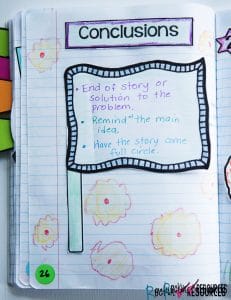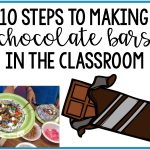Do you need ideas for writing a conclusion for a narrative story? This post will cover the meaning of a conclusion, teaching tips for brainstorming ideas to include in a conclusion, mentor text, examples, and effective teaching steps for your writing lesson plans. These ideas are ideal for any writing curriculum and are a part of a series of mini lessons for writer’s workshop designed for scaffolding through the writing process.
Common Core Standard: We can provide a conclusion that follows from the narrated experiences or events.
1. TEACH
What is a conclusion? It is the end of the story or solution to the problem. The readers should be reminded of the main idea and feel that the story has come a full circle with an ending. Don’t leave your readers hanging. Give them a solid conclusion. That doesn’t mean you can’t give them something to think about for future stories or what may happen after the story, but conclude the plot you have built up throughout the story. Come down from the heightened suspense and climax and finish the story.
2. MENTOR TEXT
Did you know that using a mentor text doesn’t mean the book has to be newly introduced? Did you read First Day Jitters at the beginning of the school year? Get the book back out, retell the story, and then read the conclusion together pointing out how it closes the story. When using mentor text for specific skills, you are mainly focusing on that skill, so it doesn’t matter if you’ve already read it.
Peter’s Chair by Ezra Jack Keats
First Day Jitters by Julie Danneburg
The Giving Tree by Shel Silverstein
3. MODEL
Always model! What does that mean? Modeling a lesson is showing students exactly how to apply the knowledge of the lesson into writing. It is best to have an ongoing story and add each lesson as you go. It creates a scaffolding approach to writing. In all of my interactive writing notebooks created for Grades 1-8, I provide modeled lessons. What does that mean? You don’t have to come up with all the ideas yourself. You can use the modeled stories as your class story. Of course you can also have students input too.
4. TAKE NOTES
I am a firm believer that taking notes or providing students with mini anchor charts for their notes is a very valuable tool. They will have this information at their fingertips when they are writing future stories. This is an example of an interactive writing notebook page using a finish line flag for the graphic so students can have a visual for finishing or ending.
5. PRACTICE
Providing practice for students is also valuable before they are asked to write a conclusion on their own. I like to give groups of students a VARIETY OF WRITING PROMPTS and ask them to create a plot with a conclusion to share with other groups or the whole class.
6. APPLY
After students have the background knowledge, modeled samples, and practice, they are ready to apply their knowledge! This is an example of an interactive writing notebook page where students write the end of their story inside a finish line flag. Then students should transfer that conclusion onto their graphic organizer for the story.
7. SHARE
Students should share their conclusions with their peers. They will get to see how other students are finishing their stories and may prompt more ideas for this writing or future writing.
I hope you gathered a few ideas useful for your own classroom or homeschool student. There are many more writing mini lessons just like this one! If you are looking for ways to write a strong conclusion, visit my post in the revising stage called HOW TO WRITE A JAMMIN’ CONCLUSION!
Check out my FREE writing masterclass! CLICK HERE
LAST LESSON: WRITING MINI LESSON #20- WRITING DIALOGUE IN NARRATIVE WRITING
NEXT LESSON: WRITING MINI LESSON #22- WRITING A ROUGH DRAFT FOR A NARRATIVE ESSAY!
This lesson is also included in the STEP-BY-STEP WRITING® Programwith mini-lessons designed to scaffold through the writing process. Writing units included are sentence structure, paragraph writing, narrative writing, opinion writing, and informative writing. See what is included in the image below and click on it to learn more about them! You will turn your reluctant writers into ROCKSTAR WRITERS™!







